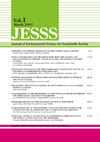This study investigated nitrous oxide (N
2O) emission and the environmental parameters responsible for its generation in Ru Cha mangrove sediment (Thua Thien Hue, Vietnam). To determine cumulative amounts of N
2O emission from different sediment layers, closed incubation experiments were conducted at 25ºC for 7 days in 100 mL glass bottles that contained 5 g of sectioned sediments (0‒5, 5–10 and 10‒15 cm depths) and 25 mL of the ambient water. Cumulative amounts of N
2O emission decreased with sediment depth, which coincided with decreases in the density of denitrifiers, and contents of total organic carbon, total nitrogen and ammonium from upper to lower sediment layers. A similar incubation experiment was conducted using the 0–5 cm sediment layer to investigate the effect of different nitrate (NO
3-) concentrations (0, 1, 3 and 5 mg N L
-1) on potential N
2O emission. Nitrous oxide emission increased with NO
3- addition, indicating that N
2O emission was limited by NO
3-. Nitrate was completely removed from the solution in all NO
3- treatments by denitrification. Nitrous oxide emission accounted for 20%, 55% and 100% of the amounts of NO
3- removed in 1, 3 and 5 mg N L
-1 treatments, respectively. Our laboratory experiments suggest that the Ru Cha mangrove forest could be a hotspot of N
2O emissions when sediment receives high NO
3- inputs.
View full abstract
